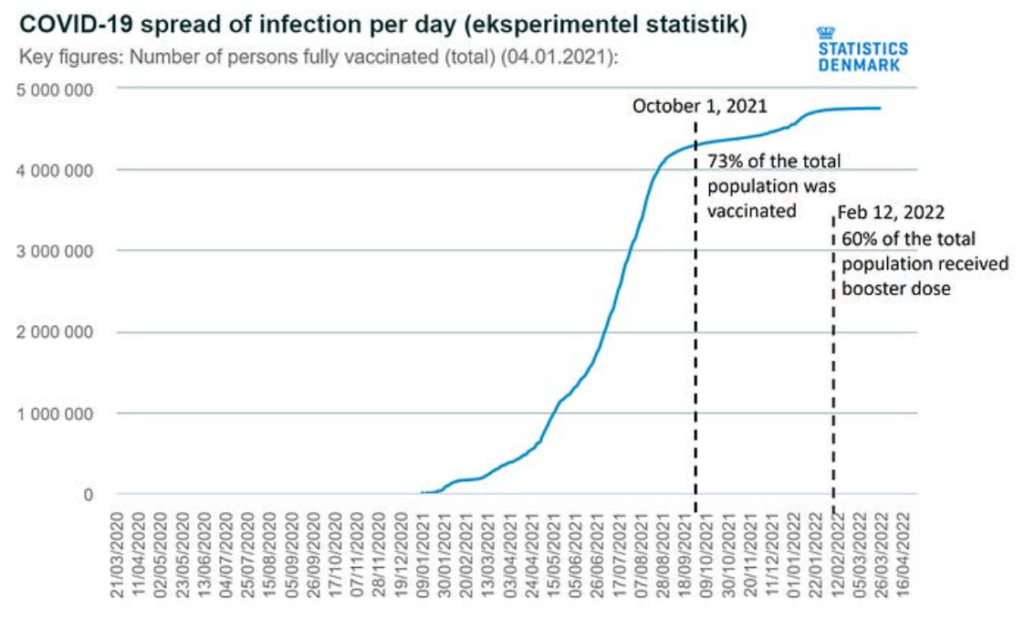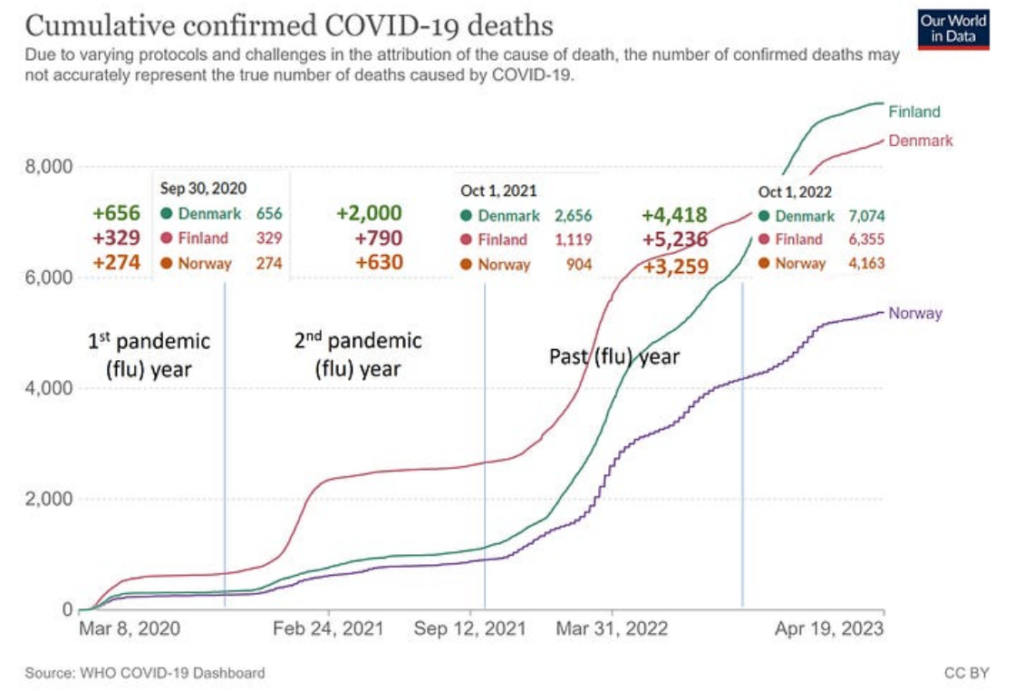How much can Denmark teach us today about the natural course of the pandemic and the effects of human interventions?
A lot. But let’s start at the beginning.
Long ago, when the world was convinced that stubborn, unlocked-down Sweden was performing a deadly Covid experiment, I explored mortality statistics in the Nordic countries. My first analysis (June 2020, published in Hebrew) was titled ‘Lockdown and Covid mortality: refutations from Sweden’. At that time Covid mortality in Sweden was about five times higher than in Denmark.
In my second analysis of the topic (January 2021, on Twitter), I compared flu, Covid and all-cause mortality in Denmark and Sweden. Over three consecutive ‘flu years’ (October through September), Sweden fared better than Denmark on flu mortality (pre-pandemic), worse on Covid mortality (when flu was absent), and better or similar to Denmark on overall mortality. My analysis was based on data through September 2020.
We now have a much wider perspective on Sweden (elsewhere and below) and Denmark (below).
For reasons that remain unknown, the first major wave of the pandemic was not synchronised worldwide. Denmark, like many other countries, experienced only a minor wave in the Spring of 2020, which was naïvely attributed to lockdown measures. Time proved that it was no more than a nature-dictated delay — until the winter of 2020-2021.
What was the excess mortality in Denmark during the pandemic?
To answer the question we first need to choose carefully a baseline mortality rate — the expected rate if there were no pandemic. That’s the key number.
As shown in the bar graph below, all-cause mortality in Denmark generally declined between 2007 and 2014. In the following five years, up to the pre-pandemic flu year (2018-19), the rate was stable except for 2017-18, a notable exception due to a severe flu season. I used the average mortality rate in those four, fairly stable years as a baseline rate (horizonal line) for excess mortality (%).

Experiencing only a minor Covid wave in the Spring of 2020, Denmark escaped excess mortality in the first pandemic flu-year: October 2019-September 2020.
Sweden, by contrast, was hit early on, ending the first pandemic flu-year with excess mortality of 4%, part of which has ‘balanced’ a mortality deficit of 3.5% in the pre-pandemic flu-year. The true Covid toll in Sweden in the first pandemic year was probably 1-2% excess mortality — not 100%, predicted by reckless models that shut down much of the world.
In the winter of 2020-2021, several months after the pseudo-success of mitigation, Denmark succumbed to its first major Covid wave. The death toll of Covid in Denmark in the second pandemic year (October 2020-September 2021) was 3.7% excess mortality, similar to Sweden a year earlier (4%).
What happened next in Denmark is nothing short of shocking. At a time that was considered post-pandemic in many countries, excess mortality in Denmark markedly increased. Not so in Sweden.
The table shows a year-by-year comparison (October through September) of excess mortality in the two countries.

First, we have no evidence that the so-called mitigation efforts had any merit in Denmark. Considering Sweden’s pre-pandemic ‘mortality deficit’, Denmark did not fare meaningfully better — if at all — over two years of the pandemic.
Second, matters got worse in Denmark in the past flu-year. Excess mortality unexpectedly rose to 9.7%, whereas it (modestly) declined in Sweden. In a country with over 50,000 deaths each year, 10% excess mortality corresponds to about 5,000 deaths above ‘normal’.
Which factors in Denmark, between October 2021 and September 2022, could have played a role?
There were at least three: Covid, flu and vaccines, primarily Covid vaccines, which were ‘highly effective‘, or not. We will return to the last topic shortly.
The two graphs below are limited to the past flu year. Regardless of misattribution of deaths to Covid, we observe a prolonged Covid mortality wave spanning six to seven months, and another small and short wave.
Synchronised below, we see a wave of seasonal flu, about two months long, partly overlapping the major Covid mortality wave. That was the first significant re-appearance of the flu in Denmark since the beginning of the pandemic.

Monthly data on all-cause mortality are well matched with these graphs (red rectangles below). For each month, I indicated the corresponding wave, if present.
A month-over-month comparison of the past flu-year with every year between 2014 and 2019 revealed at least 200 excess deaths each month (and often many more) in over 90% of the comparisons.

I previously argued that computation of Covid excess mortality should be terminated upon the return of the flu because we cannot quantify the share of the latter. I will make a semi-quantitative exception here and try to justify it.
The flu wave in Denmark was short and can account for deaths only in two to three months. It cannot account for much of the 10% excess mortality in the past flu-year. Some excess deaths might have been due to Covid vaccines and other causes such as late effects of disrupted life. Nonetheless, most of the excess mortality in Denmark must have been Covid deaths, aligned with a major, prolonged Covid wave (six to seven months) and another minor wave (two months).
Which brings us to the key point: vaccination.
By the beginning of the past flu-year, over 70% of the population of Denmark was fully vaccinated against Covid, and by mid-February 2022, 60% of the population received a booster dose. The percentages should be higher in older, vulnerable age groups.

If the vaccines were highly effective against death, why was excess mortality in Denmark so much higher than in the previous flu-year? Why was it so much higher than excess mortality in Sweden in the first pandemic year — without vaccines — when the virus was much more virulent than Omicron? Unlike Sweden, there was no ‘mortality deficit’ to account for.

Whatever the exact share of Covid deaths was, it is impossible to reconcile a highly effective vaccine with the excess mortality in Denmark in the past flu-year. Is there any epidemiologist on the planet who would claim that, without vaccination, excess mortality in Denmark would have been much higher than 10%? Five times as high, if the vaccines really were highly effective? Or even just twice as high?
It seems that countries should undergo at least two major mortality waves before reaching the endemic stage — regardless of the prevailing strain. Those that started late, like Denmark, Finland and Norway, will end late. Denmark teaches us that mediocre vaccines cannot change the natural course of a pandemic.
Dr. Eyal Shahar is Professor Emeritus of Public Health at the University of Arizona. This article first appeared on Medium.













To join in with the discussion please make a donation to The Daily Sceptic.
Profanity and abuse will be removed and may lead to a permanent ban.
Oh FFS they weren’t vaccines.
Of course they’re not going to reduce mortality.
When are you “experts” actually going to catch on?
Mistakes weren’t made. It was a deliberate cull.
Indeed. And what is this “pandemic” of which he speaks?
Exactly. And besides, name an actual vaccine for a respiratory disease which works. Nothing’s changed, they’ve just made them deadlier by orders of magnitude. ”Deliberate cull” indeed.
Culling aside, it helps legitimise widespread use of a new technology that, in November 2018, was expected to be “several years away from being tested in the U.S.”. Those several years to reach testing turned out to be very pessimistic.
https://web.archive.org/web/20220515130615/https://www.pfizer.com/news/articles/new_rna_technology_could_get_the_flu_vaccine_right_every_year
Pfizer removed the November 30 2018 date from this article circa mid 2021 so it isn’t shown on the web archive. Dates tend to be helpful on news articles so an unusual piece of information to remove.
This new technology was also legitimised by attempts to discredit alternative treatments and prevention, including vitamin D and HCQ. The medical establishment’s “relentless war” against HCQ is covered in this documentary (also featuring Dr. Peter McCullough) from 46:31:
Covidism: The Contagious Deception – 2023 Documentary – Part I – The White Rose
See also from 51:55 for the Rome Declaration concluding that this war constitutes “possible crimes against humanity”.
Historically, the medical establishment has also conducted a similar war against laetrile (used for cancer prevention and cure), thus leading to the banning of apricot kernels (a laetrile source) being sold as a food in the EU. The unethical practices of the pharmaceutical industry have been known for a long time. See for example this piece in the Independent from 2014 by Oliver Wright (now policy editor for the Times muppets):
Big Pharma lobbyists exploit patients and doctors | The Independent | The Independent
Also here:
Revealed: Big Pharma’s hidden links to NHS policy, with senior MPs saying medical industry uses ‘wealth to influence government’ | The Independent | The Independent
(Refresh page to show full article?).
Instead of sorting this out, our politicians have enabled a medical scandal far worse than anything that could have been imagined back in 2014. Is it going too far to suggest our politicians and msm who failed to pursue this story (including the Times muppets) have been criminally negligent or worse? Never forget what they have done to us.
Digging deep in to the nuances of 1918 and the Spanish Influenza that allegedly killed 50 million, one may come to the conclusion that this isn’t the first time.
Please listen to this Danish doctor talking about early studies into the effectiveness of traditional vaccines and the effect of using live against dead viruses in the vaccines.
https://www.youtube.com/watch?v=o_nKoybyMGg
Managed to slip back into the Overton window by a whisker.
Indeed. And there was no bloody pandemic. Just a bad flu season.
Do you intend to say that on every single Covid-related article?🤔
Don’t know why you have so many downticks – I presume you were being gently humorous.
I suppose I sound like a broken record but IMO it bears repeating. Fundamentally the problem with what happened with covid isn’t that masks and lockdowns and “vaccines” didn’t work as advertised, the problem is that the event (if there was one) was well within what had been accepted norms for living with such infectious diseases by carrying on as normal. That contract has been broken and unless and until that understanding is restored, we are in danger. I don’t see this view repeated enough above the line.
How aboiut almost completely ineffective “vaccines”?
According to a Pfizers own document dated Jan 2021 (released due to a FOI request) there was zero difference in lung inflammation of Covid infected Macaques whether “vaccinated” or not.
Considering Covid is a Respiratory virus I’m willing to drop the “almost”
Here is another view supplied by the Johns Hopkins University of Medicine
They recorded cases, deaths and vaccine numbers for all countries, although the accuracy and choice of scale was questionable. Either way, there is a picture here particularly the timing of the ‘vaccines’ and the 3rd wave. Denmark used 3 different ‘vaccines’: Johnson & Johnson; Oxford A/Z; Pfizer BioNtech
Compare these graphs with those for all previous respiratory outbreaks such as the Spanish Flu, where there were usually 1 or 2 waves with all subsequent waves being lower and disappearing.
Red = Cases
White = Deaths
Green = Vaccine doses
Safe jabs don’t have excess deaths
************************************
Stand in the Park Make friends & keep sane
Sundays 10.30am to 11.30am
Elms Field
near play area
Wokingham RG40 2FE
The ONS generated a report that draws the same conclusions but for political reasons could not state it;
https://open.substack.com/pub/sandrews/p/office-of-national-statistics-ons?utm_source=share&utm_medium=android